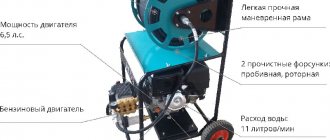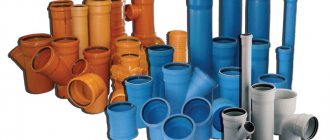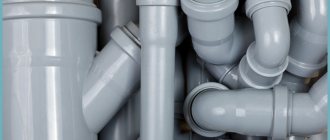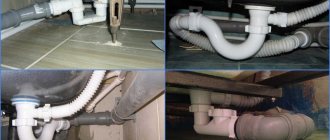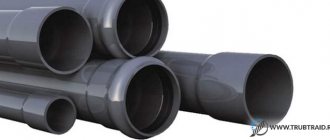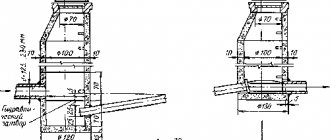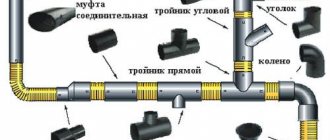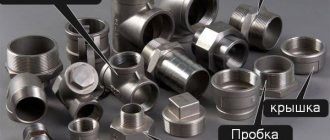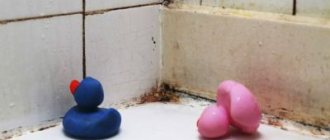When renovating a house, many are interested in how to hide pipes in the bathroom, how to design a bathroom so that the mains and other communications are not noticeable.
To this it should be added that it is important not only to close the pipes, but to do it in such a way that access to the network is free at any time.
When organizing your home, everything needs to be carefully thought through, and in the bathroom this is especially important. This is due to the specifics of the room, which is not inherently large, so it is necessary to compactly place sewer and water communications, furniture, etc.
The specificity of the bathroom lies in the fact that there is a distribution of pipes for water, for draining from the bathtub, washbasin, and toilet.
If you plan to build a new house, then the question of how to close sewer or water pipes should be thought through in advance.
What pipes can be hidden?
Before making a decision, you need to understand in detail some of the features of the connections. Some of them do not require special attention because they are reliable. They can be hidden without fear.
And some types of connections require constant monitoring during maintenance. Options for how to close pipes in the bathroom are shown in the photo. They should be studied before making a final decision.
Can be completely hidden:
- Steel pipes and joints made by welding;
- Brazed copper pipe;
- Press fittings made of metal-plastic, crimped with special pliers. And they must only be of high quality;
- Plastic water pipelines that are mounted by soldering.
But, there are types of pipe products that are not recommended to be hidden:
- Any threaded connection on pipes made of steel or other material;
- Threaded fitting on metal-plastic, assembled with a key.
Why do you need to hide sewer and water pipes?
Any utilities, in particular water supply, sewerage, gas pipelines, are laid into the house using a pipeline. It transports gas to the kitchen, water to the bathroom and toilet. Accordingly, in each of these rooms there are pipes that interfere with the beautiful interior design. To give a neat look to the room, you need to decorate or disguise them.
Before hiding the pipes, you need to decide what material will be used to carry out the event.
How to hide pipes in the wall with your own hands
Close in the wall. This method is the most popular. It is not difficult to cope with such work; in this situation, you can do without the help of professionals.
Before starting work, you need to prepare the necessary tools. If it is a water pipeline, then it is necessary to shut it off; if it is a sewer pipeline, then nothing additional needs to be done.
Then you need to develop a layout of the highway and buy material for cladding. Markings are made on the wall, and a groove will go along it. Its dimensions are calculated so that the water pipe fits freely there.
And for supplying hot water, the groove is made a little larger, because when heated it can expand.
The finished pipes are placed in the prepared recess and secured with fasteners. These fasteners can be purchased at any building materials store.
This is a very simple method. But this work involves a lot of dust and dirt. After all, before you hide the water pipes in the bathroom, you will have to cut the wall with a grinder. But, if you look from the financial side, this method is the most profitable.
You need to remember the following disadvantage. If a leak occurs, the wall will have to be dismantled to repair it.
How to choose a screen for a bath
Before making a choice, you need to measure the dimensions of the bathtub itself and the distances between the walls at the place of its installation. The latter will be needed to determine the length of the front screen if it is adjustable. You immediately need to decide on the design, namely the following parameters:
- where is a window needed to access communications;
- Which door design is more convenient – swinging or sliding;
- Is a wall needed for the end of the bathtub?
The main advice for choosing is to buy a screen whose design will provide the easiest installation and convenient access to the space under the bathroom after its installation.
It is best to take it on adjustable legs, which can be perfectly adjusted in height. It would be a good idea to pay attention to the manufacturer. It is advisable if it is a well-known brand, or a domestic company to which claims can be made regarding the quality of materials. You should definitely pay attention to the quality of the fittings. It must be waterproof and stainless. When buying a screen in an online store, you should agree on the terms of exchange or return if for some reason it does not suit you.
We recommend: Design of drainage and drainage
Installing a screen in the bathroom
Installation of a plasterboard box
How to close the sewer riser in the bathroom? In most cases, a plasterboard box is used for this, the installation of which can easily be done by hand.
How to beautifully seal a water pipe in a plasterboard box? First of all, you need to prepare materials and tools for installation:
- drywall and metal frame elements;
- pencil;
- knife and scissors for metal;
- screwdriver;
- roulette;
- level;
- drill and screwdriver;
- self-tapping screws;
- square
Work order:
- Marking.
When marking the places where the frame is attached to the walls of the room, use a level to ensure the structure is vertical. Communications must be hidden by deepening them into the frame by at least 1 centimeter.
- Installation of the metal frame of the future box.
Use a metal frame to mount the box, since a wooden frame is susceptible to moisture and can quickly collapse. Fastening occurs using dowels and self-tapping screws; installation of fasteners must be carried out in increments of 50 centimeters.
- Cutting and fastening plasterboard sheets.
Attaching drywall to the frame should be done every 30 centimeters.
- Installation of hatches on a plasterboard box at the locations of taps and other important elements (meters, threaded connections, etc.), so that, if necessary, repairs can be carried out quickly and inexpensively.
- Sealing joints.
A plasterboard box can be finished with any material: paint, tiles, wallpaper.
Rules for disguise
The features of masking pipes take into account that they must be located so that the following work can be performed:
- take readings from meters;
- shut off the water supply;
- disassemble siphon and other sewage systems;
- change and seal meters;
- check sewerage units.
It is important to leave free access to meters, taps and filters that need regular checking and replacement. If it is difficult to cope with the installation of the structure, you need to use the services of builders.
Recommendations from experts and possible mistakes
There are several rules for masking communications that should be followed.
- Firstly, try to avoid multiple joints when installing communications. To do this, it is necessary to carry out proper wiring.
- Secondly, it is important that the connections are strong and soldered from the same material.
- Thirdly, be sure to leave access to meters, valves, and taps.
Use insulating material to prevent condensation.
Disguise it under drywall
This method has currently significantly increased the number of its supporters. Because it is technologically advanced and simple.
Photos clearly demonstrate how to close water pipes in a bathroom with plasterboard. It can be seen that the plasterboard sheathing looks very aesthetically pleasing. In the same way, you can close the sewer pipeline.
The disadvantage of this method is that the room loses its dimensions. This method of hiding sewer pipes in the bathroom using drywall is perfect for a newly built house, where the owners themselves determine how to place the internal partitions.
It is not physically difficult to hide the pipeline in this way, and you do not need professional skills and knowledge for this. In old Khrushchev-era and panel houses this method also finds its application.
Pros and cons of pipe sealing
A clear advantage is the decorative design of the room, aesthetics, the absence of unnecessary details in the interior, the appearance of additional space for placing household items on it or inside it. However, there are also disadvantages: there is no direct access to the pipeline, so in the event of a breakthrough it is necessary to completely or partially dismantle the camouflage.
It is not entirely correct to choose products based on aesthetic components, since they must also have other properties.
Use of plastic panels
This method has become popular due to its simple installation. The work pattern is similar to how we did plasterboard sheathing. In this case, a frame is also constructed from metal profiles, and then it is sheathed with plastic.
It is not recommended to lay sewer or water pipes inside the rack profile. Here they can be damaged by self-tapping screws.
Basic requirements for sealing materials
The material must meet the following criteria:
- Resistance to humidity and temperature changes
- Lightness, so as not to overload the space of the room
- Easy to install
- Resistance to household chemicals used during cleaning
- Affordable price
- Long service life
The material with which the water pipes will be closed must be resistant to moisture.
How to hide in a niche
Often, niches are provided in many apartments for the installation of water supply and sewer risers. When there are such, it is considered great luck.
Hiding communications in this case is very simple. The most important advantage of this situation is that all the work is done without wasting space in the room.
The essence of this method is that tiles are placed over the edges of the niche. It should extend a few centimeters beyond the edge.
After the glue has dried, the seams are grouted on the tiles. On both sides of the edge that protrudes, a direct connection for the plastic is glued.
The panels are tucked into it. They are mounted horizontally. If you don’t plan to hang anything on this wall, then you don’t have to add additional stiffeners.
If you need to hang something on the wall, then profiles should be placed in the places where it is planned. They are attached directly to the wall.
The described method is used in cases where it is necessary to provide a quick approach to the highway. If the quality of the network installation is impeccable, then the niche is allowed to be covered with plasterboard.
This work is a little more complicated than plastic sheathing. Because guide profiles are mounted to the edges of the niche. Jumpers are attached to them. And after that the structure is sheathed with plasterboard.
Provided that water meters are located in the niche, it is worth remembering that it is necessary to leave a hatch. The simplest option is to cut a hole of the required dimensions into which the hatch is glued.
Types of screens
By design, all bath screens can be divided into three main types:
- deaf;
- with doors providing access to communications;
- with sliding or hinged doors covering the main space under the bathroom.
Such screens are made from lightweight and durable materials that are not afraid of moisture and temperature changes. Today you can find on sale designs made from:
- plastic;
- polyvinyl chloride;
- acrylic;
- MDF;
- polystyrene;
- metal;
- glass
There may be screens made from a combination of these materials, which expands the possibilities for interior decoration. All these materials are not afraid of chemical attack, they are easy to clean using any means and have an aesthetic appearance.
You can buy screens that cover the space under the bathtub, both from the front and additionally from the end side. Such screens are suitable for large bathrooms, where the bathtub is not located close to the walls of the bathroom.
Hiding the pipeline in the floor
Speaking about methods of placing communications, it is worth remembering another interesting method. You can close it in the floor.
This solution to the problem is attractive because it does not require gating. The pipes are laid on the floor slab and secured. After this, the screed is poured.
The disadvantage of this method is that sewer pipelines cannot be hidden in the floor. They will have to be laid using the usual old method - in grooves.
Why hide pipes?
The bathroom is an important part of a house or apartment, which people always strive to give a cozy and beautiful look.
But even the most high-quality and fashionable renovation will not bring joy if pipes and other communications remain visible. In addition, drops of water often collect on unmasked pipes due to high humidity in the room. The result will be darkening of the pipes over time. Proper camouflage of pipes is mandatory during renovation; it will make the room neat and its design stylish and modern.
Plumbing roller shutters
In the search for methods on how to close the pipes in the bathroom, they just couldn’t come up with anything, the photos show various options for getting out of this situation.
And we can’t help but mention another good and simple method. Its essence is simple - it is the use of sanitary roller shutters. In this situation, they perform a number of functions:
- Communications are closed;
- Reduce the noise of plumbing fixtures;
- Increase the level of interior aesthetics;
- Allows full access.
The advantage of this method is obvious. Roller shutters do not hide space; when assembled, they are located in a box, and when deployed, they cover what is located behind them.
To approach communications you only need one simple movement of the hand.
Hiding with furniture
If the above methods cannot be used in the bathroom, then there is another very simple method. It is recommended to place communications in the furniture design.
This can be done after all repair work is completed. It is best to do this when hanging cabinets, mirrors, or installing cabinets.
Furniture in this situation not only masks communications, but is also used for its intended purpose. It is very convenient that, if necessary, there is always full access to the pipes.
High humidity in the bathroom places additional demands on furniture. Waterproof materials are not cheap, and not everyone can buy such a headset. In this case, it is recommended to install mechanical forced ventilation. This way you can regulate the microclimate and ensure the necessary air exchange.
There are many ideas on how to hide pipes in the bathroom. Which way to go is up to everyone to decide for themselves. It all depends on the preferences and capabilities of each person.
The main thing is to approach this issue thoughtfully and choose the option that is suitable for a particular room. Then you will be pleased with the new and improved bathroom interior.
How to hide communications using a false wall
If, when finishing a new room or seriously renovating an old one, all communications can be run along one wall, the best way is to install a false wall made of plasterboard, behind which you can hide all the pipes.
Advantages of the method:
- Easy to install and dismantle.
Installing a false wall made of plasterboard to mask communications is in many ways simpler than installing a box made of the same material, since most of the time you are installing entire (or large) sheets of material on the wall of the room, you will not have to make a large number of cuts.
- Light weight.
- Durability.
- Ability to withstand heavy loads.
You can hang a large amount of plumbing equipment, shelves and other accessories on a false plasterboard wall without worrying about its safety.
- Versatility.
How to seal protruding water supply pipes to bathroom faucets? In some cases, it is prohibited to tap walls, as this may adversely affect the load-bearing capacity of the enclosing structure. A plasterboard wall can be installed anytime, anywhere.
- Wide range of finishing options.
Any finishing coating can be applied to a false plasterboard wall: paint, wallpaper, tiles. If you choose the latter option, for maximum reliability of fixing the tiles on top of the drywall, install a special mesh.
The only significant disadvantage of this method of masking communications is the reduction in the volume of the room. This drawback can be eliminated by installing storage shelves in the false plasterboard wall.
Hiding communications under the bathroom
Quite often, the largest parts of systems pass under the bowl. Of course, you can put it on legs and mount a decorative screen or screen, but the best way to hide communications under the bowl from a design point of view is to install a podium.
First of all, when planning a podium, you need to choose the material from which it will be made. A bathroom is a room with a high level of humidity, so not all types of materials are suitable for constructing a podium. You can use:
- High-quality drywall, resistant to prolonged exposure to moisture.
- Brick.
- Foam blocks.
The most convenient option is plasterboard, since the installation of this material is characterized by high speed and minimal complexity. The main thing when choosing a material is to take into account that a filled bathtub can weigh up to 250 kilograms, which means you need to choose a design that can easily withstand such weight.
Ideas on how to hide communications under the sink
How to close the pipes under the bathroom sink? Ideas that are the most popular and interesting:
- Installation of plasterboard box under the sink.
This option allows you to achieve maximum compliance of the sink with the style of the room.
- Installation of a pedestal for a sink.
The cheapest and easiest way. The sewer and water outlets are located in one place, the main thing is to maintain the minimum slope of the sewer.
- Installation of a wall-hung sink with a rear exit and hidden installation in a box (or false wall) made of plasterboard.
- Installation of furniture with a built-in sink.
The most popular method, since currently there is a huge variety of furniture for sinks of all types.
Possible mistakes
Before closing engineering systems in a bathroom or toilet, you first need to make sure that the selected communications must be freely accessible. For example, hot water meters or a threaded connection where the likelihood of a leak is greatest.
In addition, you need to make sure that there are no disruptions to systems when hiding systems. Quite often, many people forget about the required slope of the sewerage system when they hide it in a plasterboard box.
The most common problems that arise from errors in masking sewer and water supply systems.
- Lack of access to taps.
If you want to disguise the system even at the location of elements that require direct access, install special inspection hatches. Currently, there is a large selection of such elements; they differ in the method of opening and design (for example, there are hatches that can be closed, disguised as tiles).
- The occurrence of leaks.
The most vulnerable points of the water supply system are threaded connections. Monitor the tightness of the joints and the quality of the sealant used, and also leave service hatches for quick repairs if necessary.
- Difficult installation of additional elements.
Before renovating a room, decide on the location of all household appliances. Otherwise, when you hide all the elements, connecting a new device (for example, a washing machine) will be quite problematic.
The main thing when installing sewerage and water supply systems is the use of high-quality materials and accuracy during work. Otherwise, even following all the rules can lead to leaks with the subsequent need for expensive repair work.
A little about the types of wiring
The main rule is that pipes should be laid in a certain sequence. Even those who are doing it for the first time can easily do this work with their own hands.
But sequential wiring also has a number of disadvantages. The main one is that the pressure is distributed unevenly across such systems. This means that it is not recommended to turn on water in several consumers at once.
What is important to know before installation
Before starting work, it is necessary to reduce the likelihood of an emergency, seal all connections: bends, turns, all joints. If the pipes are old, you can completely replace them. You also need to think about how to provide access to meters, valves and dampers after installing camouflage structures, and leave space for installing special inspection (inspection) doors.
The design should not clutter up the small area of the room, so you should choose materials that do not require a massive frame.
How to mount a decorative pipe box
The answer to the question of what purposes decorative boxes for heating pipes (gas, water) are intended for is already contained in the question itself. Very often, carried away by global changes when carrying out renovations in an apartment or private house, upon completion, we are surprised to discover that all our efforts to bring beauty to the bathroom, kitchen, if not gone down the drain, are significantly spoiled by radiators and heating pipes, water supply, etc.
This is especially true for apartments and old housing stock during their cosmetic renovation. That is, without replacing communications. But the repairs have been completed, but the problem with the pipes remains. It is precisely for such cases that the screens and decorative boxes for heating pipes in the photo are intended.
Material of the outer skin of the frame
As a finishing material, you can use:
- eurolining,
- MDF panel,
- plastic,
- perforated metal plates (grids).
The most popular material for finishing boxes is (considered) gypsum plasterboard sheet (GPS). This is explained by the fact that in the future the surface of the gypsum plasterboard box can be decorated with facing tiles, film, wallpaper, or simply painted in any color at will or in accordance with the design project. Despite the fact that masking communications screens and boxes have a sufficient number advantages:
- Very low cost (if installed by yourself). They can be made from leftover material left over from repairs.
- Arbitrary sizes. This is especially true for hard-to-reach areas and non-standard pipe layouts.
- They also have a number of disadvantages:
- If an emergency occurs with a water supply (heating) pipe, to eliminate it you will need to remove the entire lining of the box.
- Restoring the cladding will require new (partially or completely) materials.
Plastic decorative boxes for heating pipes
- the most affordable boxes and decorative screens (grids),
- practical to maintain,
- do not need painting,
- universal for gas, sewer and cold water pipes.
Due to the popularity of such boxes, manufacturers often use low-quality plastic. Cannot withstand prolonged exposure to high temperatures (hot water supply, heating pipes). As a result, the decorative box:
- deformed,
- changes color
- become fragile.
The plastic box in the form of a plinth deserves special attention. But it already belongs to a different, higher price category.
Plastic decorative boxes for heating pipes
- the most affordable boxes and decorative screens (grids),
- practical to maintain,
- do not need painting,
- universal for gas, sewer and cold water pipes.
Due to the popularity of such boxes, manufacturers often use low-quality plastic. Cannot withstand prolonged exposure to high temperatures (hot water supply, heating pipes). As a result, the decorative box:
- deformed,
- changes color
- become fragile.
The plastic box in the form of a plinth deserves special attention. But it already belongs to a different, higher price category.
Eight options for closing plumbing, choosing the optimal one
There are many ways to hide plumbing in your toilet and bathroom. But before considering specific methods, you need to know the answer to the main question - are they masking pipes during their laying or do they want to hide already laid communications .
In the first case, the pipes are filled with floor screed or placed in niches hollowed out in the walls. In the second, boxes or special furniture structures are built, roller shutters are installed, etc.
To choose the best option for masking pipes with all their bends and branches, first the pipeline routes are marked on the wall with a pencil. Or they draw a diagram on paper, maintaining the scale. After this, they decide where to ditch the wall, and where to install a box or build some other structure.
Advantages and disadvantages
| Way | Pipe location | Advantages | Flaws |
| Plastic panels | Vertical | 1. Comparatively cheap.2. Ease of installation.3. The structure can be quickly disassembled and reassembled. | 1. The fragility of the plastic and insufficient rigidity of the entire structure.2. Reducing the usable area of the room. |
| Drywall boxes | Vertical and horizontal | 1. Possibility to hide wide main pipes.2. Strength and rigidity of the structure.3. Possibility of tiling. | Inability to access the pipeline without dismantling the entire structure. |
| False wall | Vertical | The effect of the complete absence of any eyeliners or other connections. | High cost. Reduction of usable area of the room. |
| Homemade lockers | Vertical | 1. Practicality.2. Aesthetics.3. Additional space for household needs. | They deteriorate from high humidity. |
| Plumbing furniture | Vertical | 1. Giving the interior a rich and chic look.2. Ease of installation.3. Additional storage space. | 1. High price.2. Requires careful handling and constant care. |
| Roller shutters | Vertical | 1. Mobility.2. Possibility of access to the entire pipeline at any time. | 1. High price.2. Softness of the lamellas.3. High risk of damage due to impact or other mechanical impact. |
| In the floor screed | Horizontal | 1. Freeing up additional work space.2. Possibility of implementing any design solutions. | 1. Impossibility of repairing the pipeline without destroying the entire floor.2. Not suitable for hiding sewer pipes. |
| Wall chipping | Vertical | 1. The optimal solution from a financial point of view.2. Space saving.3. Possibility of obtaining a perfectly flat wall. | 1. A lot of dust, dirt and construction debris during work.2. Impossibility of repairing the pipeline without destroying the wall lining.3. Restrictions on pipe diameter (up to 50 mm). |
Methods for masking pipes in photos
Pipes can be hidden in the floor screed
Wall chipping allows you to realize any design ideas
Furniture adds luxury and chic to the bathroom
Pipe cabinet
The pipeline is behind a false wall
Pipes are hidden in a plasterboard box
Bathroom cladding with plastic panels
Ways to hide communications
There are several ways to cope with the task.
However, the simplest situation will be when the renovation of a room is done from scratch and all the little details are taken into account.
The implementation of which can be thought through initially, so that no problems arise later.
Material of the outer skin of the frame
As a finishing material, you can use:
- eurolining,
- MDF panel,
- plastic,
- perforated metal plates (grids).
The most popular material for finishing boxes is (considered) gypsum plasterboard sheet (GPS). This is explained by the fact that in the future the surface of the gypsum plasterboard box can be decorated with facing tiles, film, wallpaper, or simply painted in any color at will or in accordance with the design project. Despite the fact that masking communications screens and boxes have a sufficient number advantages:
- Very low cost (if installed by yourself). They can be made from leftover material left over from repairs.
- Arbitrary sizes. This is especially true for hard-to-reach areas and non-standard pipe layouts.
- They also have a number of disadvantages:
- If an emergency occurs with a water supply (heating) pipe, to eliminate it you will need to remove the entire lining of the box.
- Restoring the cladding will require new (partially or completely) materials.
Frame covered with tiles
Tile is an ideal material for cladding walls or protective boxes in rooms with high levels of humidity. Laying tiles requires constructing a frame and covering it with plasterboard. This process requires a lot of time and certain skills. The step-by-step instructions for carrying out the work are as follows:
- Measurements of the location of water supply and sewerage pipes.
- Construction of a metal or wooden frame. If the second option is used, then the surface is treated with antiseptic impregnations.
- Sheathing the sheathing with moisture-resistant plasterboard, chipboard or plywood. Self-tapping screws are used for fastening.
- Fixing the reinforcing mesh on top of the box. It is necessary to strengthen the base, as the tiles can be heavy. To fasten the mesh, rivets or self-tapping screws are used. The material must be in tension. After this, tile adhesive is applied to the surface. You can fix the tiles to the base within a day.
- Installation of tiles. In order for it to be correct, you should first mark the order of gluing the fragments. Tile adhesive is used to fix the fragments. To ensure that the distance between them is the same, plastic crosses are used.
- Grouting tile joints with a product with antifungal properties. This procedure is carried out after 24 hours.
READ ALSO: Do-it-yourself welding of plastic pipes: training and step-by-step instructions
The choice of box shape depends on the location of the water supply junction. Sometimes it should be extended until the wash itself.
